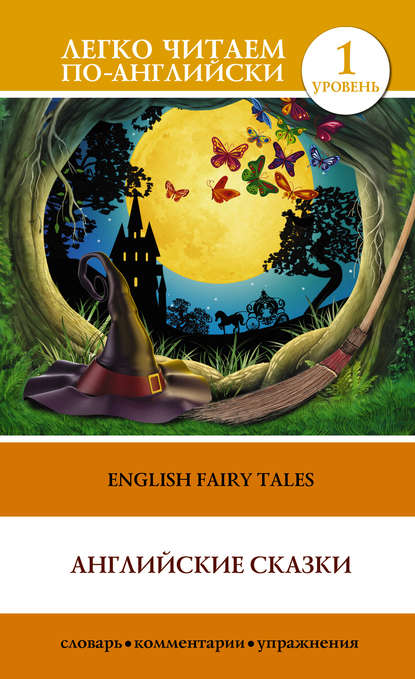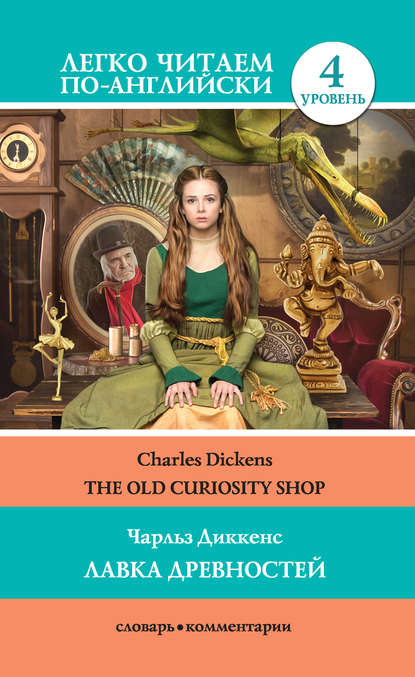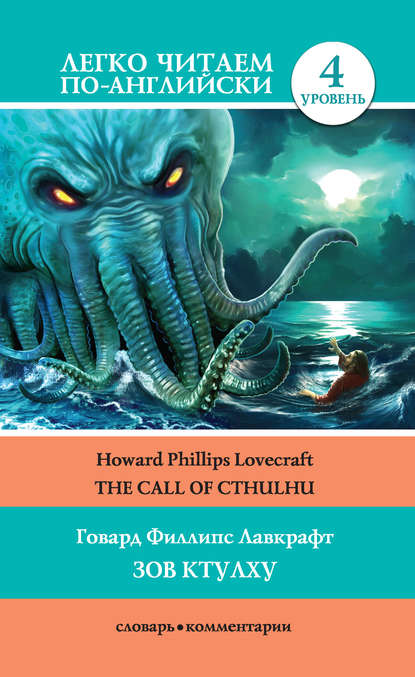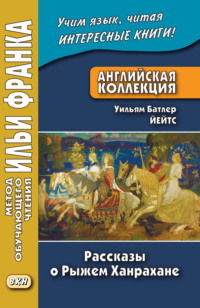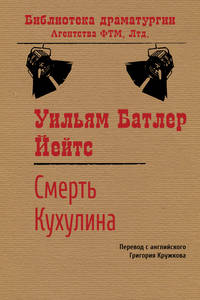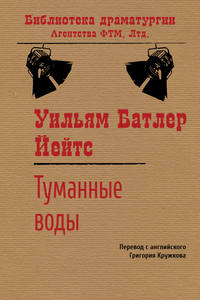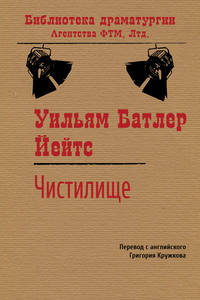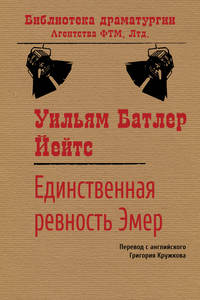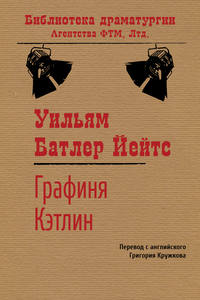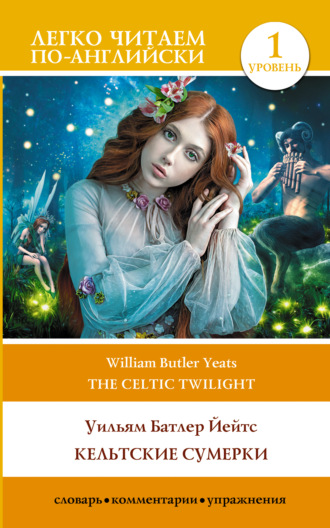
Полная версия
Кельтские сумерки. Уровень 1 / The Celtic Twilight

Уильям Батлер Йейтс
Кельтские сумерки. Уровень 1 / The Celtic Twilight
Адаптация текста и словарь М. Кузнецовой
Дизайн обложки Анастасии Орловой
© Кузнецова М. М., адаптация, словарь, 2023
© ООО «Издательство АСТ», 2023
* * *THE HOSTING OF THE SIDHE[1]
The host is riding from Knocknarea[2],And over the grave of Clooth-na-bare[3];Caolte[4] tossing his burning hair,And Niamh[5] calling, “Away, come away;Empty your heart of its mortal dream.The winds awaken, the leaves spin around,Our cheeks are pale, our hair is unbound[6],Our chests are moving, our eyes are shining,Our arms are waving, our lips are apart,And if anyone looks at our rushing band,We come between him and the deed[7] of his hand,We come between him and the hope of his heart.”The host is rushing between night and day;And where is there hope or deed as fair?Caolte tossing his burning hair,And Niamh calling, “Away, come away.”THIS BOOK
Time drops in decayLike a candle burnt out.And the mountains and woodsHave their day, have their day;But, kindly old routOf the fire-born moods,You pass not away.I wanted to create a small world from the beautiful and meaningful things in this imperfect[8] world, and to show a little piece of Ireland to my own people. I have written down what I have heard and seen. I haven’t separated my beliefs from those of the common people. I have let my characters, including ghosts and fairies, go their own way. The things a person experiences are life’s memories, and anyone can interpret[9] them as they please. I have also interpreted them in my own way, but I will be happy as long as my interpretation suits me.
1893.W. B. YEATS.A TELLER OF TALES
Paddy Flynn told me many of the tales in this book. He lived in a small and leaky[10] cabin in Ballisodare[11] village. He described it as the most peaceful place in County Sligo. This place is filled with fairies. The first time I saw him, he was cooking mushrooms. The next time, he was sleeping under a hedge[12] with a smile on his face. He was always happy. But I could sense a hint of sadness in his eyes.
And yet there was much in his life to depress[13] him, for his age, eccentricity, and deafness, and the children were constantly bothering him. Probably that’s why he always advised to be happy and hope for the best.
I wrote down Paddy Flynn’s stories and words in my notebook after meeting him. I feel sad looking at the empty pages at the end that will never be filled. Paddy Flynn passed away[14]. A friend of mine gave him a big bottle of whiskey, and even though he was usually not a heavy drinker[15], he got really excited from this gift, and he didn’t stop drinking for a few days until he passed away. His body was tired from old age and difficult times, and it couldn’t handle the alcohol like it did when he was young.
BELIEF AND UNBELIEF
Some people in the western villages have doubts. Last Christmas, a woman told me that she didn’t believe in hell or ghosts. She thought that hell was made up by the priest[16] to make people behave, and she didn’t think ghosts could freely walk the earth. But she believed in fairies, leprechauns[17], kelpies[18], and fallen angels. I also met a man with a tattoo of a Mohawk Indian on his arm who had similar beliefs and doubts. He said that people never doubt that fairies are real.
A young girl who worked in the village of Grange, near the slopes of Ben Bulben[19],disappeared one night around three years ago. People said that the fairies had stolen her.
A village resident tried to stop them from taking her. But he ended up with nothing in his hands except a broomstick[20]. The villagers asked the constable[21] for help, and he immediately started searching every house. He also advised the villagers to burn all the ragweed[22] on the field where the girl disappeared because ragweed is sacred[23] to the fairies. They spent the whole night burning the ragweed while the constable said special words. In the morning, they found the little girl walking in the field. She said that the fairies had taken her very far away, riding on a magical horse. Eventually, she saw a big river, and the man who tried to save her was floating down the river in a small boat.
MORTAL[24] HELP
Long ago in stories, men were taken away to assist the gods in a battle. Cuchullan[25] helped the goddess Fand’s[26] to defeat another nation and gained her favor. I’ve also heard that the fairies folk can’t even play their game called hurley[27] unless they have a mortal on each team. Without the help of mortals, the fairies folk are weak and cannot even hit the balls. One day, me and my friend were walking on some marshy[28] land in Galway when we saw an old, tough-looking man digging a ditch. My friend had heard that this man had seen something amazing. And eventually we get this story from him. When he was a young boy, he was working with around thirty other men, women, and boys. They were near Tuam[29], not too far from Knock-na-gur. Suddenly, they all saw about one hundred and fifty fairies folk from a distance of around half a mile. There were two of them, he said, in dark clothes like people of our own time, who stood about a hundred yards from one another. The others wore colorful clothes.
He could not see what they were doing, but it seemed like they have been playing hurley. Sometimes they would disappear, and then they came back out of the bodies of the two men in dark clothes. These two men were of the size of living men, but the others were small. He saw them for about half-an-hour, and then the old man he was working for said, “Get on, get on, or we will have no work done!” I asked if he saw the fairies too, “Oh, yes, but he did not want work he was paying wages for to be neglected[30].” He made everybody work so hard that nobody saw what happened to the fairies.
1902.A VISIONARY[31]
One evening a young man came to my house and started talking about the creation of the earth and heaven and many other things. He had written many poems and painted many mystical drawings. But lately he hadn’t written or painted anything. He feared that the emotional life of the artist was bad for him. However, he willingly recited[32] his poems. Suddenly it seemed to me that he was looking around a little nervously.
“Do you see anything, X–?” I said. “A shining woman, covered by her long hair, is standing near the doorway,” he answered. “Is it some living person who thinks of us?” I said; “No,” he replied; “If it was alive I would feel that. It is a spirit. It is someone who is dead or who has never lived.”
I asked him what he was doing, and he said that he worked as a clerk in a big store. However, he enjoyed walking around the hills and talking to eccentric farmers. He would also make strange and guilt-ridden[33] people to share their problems with him. Another night, when I was at his place, more than one person came to discuss their beliefs and doubts. Sometimes he had visions[34] while talking to them. He has accurately[35] told several people about their past and distant friends, leaving them silent. Even though he was young, he’s much more clever than the oldest people around.
The poetry he recited to me was full of his nature and his visions. Sometimes it was about past lives that he had lived, and sometimes about people from those lives. I told him I wanted to write an article about him and his poetry, and he said that I could do so, but he asked me not to mention his name. He wished to stay “unknown.” The next day, he sent me a collection of his poems along with a note that said: “Here are copies of the verses you liked. I don’t think I’ll ever be able to write or paint anymore. I’m preparing myself for a new life.”
I remember one person in particular. A winter or two ago, he spent much of the night walking up and down the mountain, talking to an old peasant. Both of them were unhappy: X– because he had realized that art and poetry weren’t for him, and the old peasant because his life was ending without any achievements or hope left. Both of them were so Celtic! They were always striving[36] for something that couldn’t be fully expressed in words or actions. The peasant was lost in his mind with sadness. Once he exclaimed, “God owns the heavens, but He wants the world”; and once he complained that his old neighbors were gone and everyone had forgotten about him. They used to bring a chair for him by the fire in every cabin, but now they asked, “Who is that old man over there?” He said, “I feel doomed[37],” and then continued talking about God and heaven. He also said more than once, pointing his arm towards the mountain, “Only I know what happened under the thorn-tree[38] forty years ago,” and as he said it, tears sparkled on his face in the moonlight.
VILLAGE GHOSTS
On old maps, unexplored areas were marked with “Here are lions.” In the villages of fishermen and farmers, we can only write: “Here are ghosts.”
My ghosts live in the village of H–, in Leinster[39]. A person needs to be very careful when passing the village at night. Someone once complained, «By the cross of Jesus! How can I go? If I pass by Dunboy Hill, old Captain Burney might see me. If I go around by the water and up the steps, there’s the headless one and another on the quays[40], and a new one under the old churchyard wall. If I go all the way around the other way, Mrs. Stewart appears at Hillside Gate, and the devil himself is in Hospital Lane.”
I don’t know which spirit he met, but I’m certain it wasn’t the one in Hospital Lane. During the time of cholera, there was a building there to treat patients. After the need was gone, it was torn down, but ever since, the area has been haunted by ghosts, demons, and fairies. There’s a strong farmer in H– named Paddy B–. One night, while passing through Hospital Lane, he saw what he initially thought was a pet rabbit, but then realized it was a white cat. As he came closer, the creature started growing bigger and bigger. The farmer felt his strength draining away, as if it was being sucked out of him. He turned and ran away.
The “Fairies Path” runs through Hospital Lane. Every evening, the fairies travel from the hill to the sea and back again. There’s a cottage at the end of their path, by the sea. One night, Mrs. Arbunathy, who lived there, was waiting for her son to come home and left the door open. Her husband was asleep by the fire when a tall man entered and sat beside him. After a while, the woman asked, “Who are you in God’s name[41]?” The man got up and left, saying, “Never leave the door open at this hour, or something bad may happen to you.” She woke up her husband and told him what happened. He said, “One of the good people has been with us.”
The man probably met Mrs. Stewart at Hillside Gate. When she was alive, she was the wife of the Protestant priest. The village people say that her ghost never harmed anyone.
Not far from Hillside Gate, where she haunts, there was a more interesting spirit for a short time. It appeared in a green lane at the western end of the village. Here’s the story in detail: In a cottage at the village end of the green lane, lived a house painter named Jim Montgomery and his wife. They had several children. One day, he beat his wife, who was a very large woman. Her sister heard about it and came over. She took down one of the window shutters and beat him with it. Jim Montgomery’s behavior worsened over time, and his wife began to go hungry. She didn’t tell anyone because she was very proud. Sometimes, she wouldn’t even have a fire on a cold night. People in the area often heard her husband beating her, but she never told anyone. She became very thin. Finally, one Saturday, there was no food in the house for her and the children. She couldn’t bear it anymore and went to the priest to ask for some money. He gave her thirty shillings. Her husband met her, took the money, and beat her. On the following Monday, she became very ill and sent for Mrs. Kelly. As soon as Mrs. Kelly saw her, she said, “My dear, you’re dying,” and called the priest and the doctor. She died within an hour[42]. After her death, the landlord had taken children to the workhouse[43]. A few nights after they left, Mrs. Kelly was walking home through the green lane. The ghost of Mrs. Montgomery appeared and followed her. It didn’t leave her until she reached her own house. She told the priest, Father R, but he didn’t believe her. A few nights later, Mrs. Kelly met the spirit again in the same place. She was too terrified to go the whole way and stopped at a neighbor’s cottage halfway, asking them to let her in. She cried out, “In the name of God, let me in, or I will break open the door.” They opened the door, and she escaped from the ghost. The next day, she told the priest again. This time he believed her and said the ghost would continue to follow her until she spoke to it.
She met the spirit again in the green lane. She asked why it couldn’t rest. The spirit said they need to take its children from the workhouse and to say three masses[44] for its soul to find peace. “If my husband doesn’t believe you,” she said, “show him this.” She touched Mrs. Kelly’s wrist with three fingers, and the places where they touched turned black. Then the spirit was gone. Montgomery, for a while, didn’t believe that his wife had appeared. He said, “She wouldn’t show herself to Mrs. Kelly, she prefers to appear to respectable people.” But he believed it when he saw the three marks, and took the children out of the workhouse. The priest said the masses, and the ghost hasn’t shown up since. Some time later, Jim Montgomery died in the workhouse because of extreme poverty caused by drinking.
One person saw a woman with white borders on her cap following him, when he was passing the old graveyard wall at night. The strange woman only leaves him when he reaches his own door. The villagers believe that she follows him to seek revenge for some wrongdoing[45]. “I will haunt you when I die” is a common threat. His wife was once scared by what she believes was a demon in the form of a dog.
These are a few examples of outdoor spirits. The more domestic ones gather indoors.
One night, Mrs. Nolan was watching over her dying child in Fluddy’s Lane. Suddenly, she heard knocking at the door. She didn’t open it, fearing it was something inhuman. The knocking stopped. After a while, the front door and then the back door burst open and closed again. Her husband went to see what was wrong and found both doors locked. The child passed away. The doors opened and closed again as before. Then Mrs. Nolan remembered that she had forgotten to leave a window or door open, as is customary[46], for the soul’s departure.
House ghosts are usually harmless beings. They bring good luck to those who live with them. I remember two children who slept in one small room with their mother, sisters, brothers, and a ghost. They sold herrings[47] in the streets of Dublin and didn’t mind the ghost much because they knew they would always sell their fish easily as long as they sleep in the “haunted” room.
I know some people who can see ghosts in the villages of western Ireland. The stories from Connaught[48] are different from those in Leinster. The spirits in H– have a serious and dark manner. They appear to announce someone’s death, fulfill obligations[49], seek revenge[50] for wrongs, and even pay their debts[51]. It’s demons, not ghosts, that transform into white cats or black dogs. The tales from the west have a strange charm. The people who share these stories live in wild and beautiful landscapes. They are farmers and workers who sometimes go fishing. The ghosts here have a good sense of humor. In one western town, spirits are so energetic that if someone who doesn’t believe in them dares to sleep in a haunted house, they throw him out of the window with his bed. In the villages nearby, these creatures take on the most unusual looks. For example, a dead old gentleman steals cabbage from his own garden looking like a large rabbit. And a wicked sea captain stayed inside the plaster of a cottage wall for years, making scary noises in the form of a snipe[52].
“DUST HAS CLOSED HELEN’S EYE”
I recently visited a small group of houses called Ballylee in County Galway, Ireland. It’s not big enough to be called a village, but its name is well-known in the west of Ireland. There is an old square castle called Ballylee, where a farmer and his wife live. There’s also a cottage where their daughter and son-in-law[53] live, and a small mill with an old miller. Last year, I went there a few times to talk to the miller about Biddy Early, a wise woman who lived in Clare years ago. I wanted to know about her saying, “There is a cure for all evil between the two mill-wheels of Ballylee,”. I visited again this summer, and I plan to go back before autumn because Mary Hynes, a beautiful woman whose name is still remembered, died there sixty years ago. An old man guided me away from the mill and the castle, down a narrow path covered in brambles and sloe bushes[54]. I talked to him about a poem in Irish that Raftery[55], a famous poet, wrote about her.
I first heard about the poem from an old woman who lives about two miles up the river. She remembers Raftery and Mary Hynes. She said, “I have never seen anyone as beautiful as she was, and I never will until I die.” She told me that Raftery was nearly blind and had no other way of making a living than going around and reciting poems.
She sang the poem to me and a friend in Irish, and every word was clear and expressive. My friend and I have translated parts of it, but some of it was translated by the local people.
Going to Mass by the will of God,The day came wet and the wind rose;I met Mary Hynes at the cross of Kiltartan,And I fell in love with her then and there.I spoke to her kind and mannerly,As by report was her own way;And she said, “Raftery, my mind is easy,You may come today to Ballylee.”When I heard her offer I did not linger,When her talk went to my heart my heart rose.We had only to go across the three fields,We had daylight with us to Ballylee.The table was laid with glasses and a quart measure,She had fair hair, and she sitting beside me;And she said, “Drink, Raftery, and a hundred welcomes,There is a strong cellar in Ballylee.”Oh star of light and Oh sun in harvest,Oh amber[56] hair, Oh my share of the world,Will you come with me on SundayTill we agree together before all the people?I would not grudge[57] you a song every Sunday evening,Punch on the table, or wine if you would drink it,But, Oh King of Glory, dry the roads before me,Till I find the way to Ballylee.There is sweet air on the side of the hillWhen you are looking down upon Ballylee;When you are walking in the valley picking nutsand blackberries,There is music of the birds in it and music of the Sidhe.What is the worth of greatness till you have the lightOf the flower of the branch that is by your side?There is no god to deny it or to try and hide it,She is the sun in the heavens who wounded my heart.There was no part of Ireland I did not travel,From the rivers to the tops of the mountains,To the edge of Lough Greine[58] whose mouth is hidden,And I saw no beauty but was behind hers.Her hair was shining, and her brows were shining too;Her face was like herself, her mouth pleasant and sweet.She is the pride, and I give her the branch,She is the shining flower of Ballylee.It is Mary Hynes, this calm and easy woman,Has beauty in her mind and in her face.If a hundred clerks were gathered together,They could not write down a half of her ways.An old weaver[59] says, “Mary Hynes was the most beautiful person ever. My mother used to tell me about her. She was always dressed in white and visited every hurling match. Eleven men asked her to be their wife in one day, but she said “no” to all of them. One night, some men were sitting together, drinking and talking about her. One of them decided to go to Ballylee and see her. However, he fell into Cloon Bog and was found dead the next morning. Mary died of fever before the famine.” An old woman from Derrybrien[60] recalls Mary. She says, “No one has ever been as beautiful as Mary. Her skin was so white that it looked blue, and she had two little blushes on her cheeks.” Another wrinkled woman living near Ballylee says, “I often saw Mary Hynes, and she was really beautiful. She had two curls on each cheek that were silver-colored. I also saw Mary Molloy, who drowned in the river, and Mary Guthrie from Ardrahan[61], but Mary Hynes was the most beautiful of them. She had seen too much of the world. She was a kind person. One day, I was walking through a field, feeling tired, and the Poisin Glegeal (the shining flower) appeared and gave me a glass of fresh milk.” A man by the shore in Kinvara[62], who is too young to remember Mary Hynes, says, “Everyone says there is no one as beautiful as her now. They say her hair was the color of gold. She was poor, but she always dressed nicely. If she attended any gathering, everyone would fight to catch a glimpse of her. Many people were in love with her, but she died young. It is said that anyone who has a song written about them won’t live long.”
People believe that those who are greatly admired are taken by the Sidhe (fairies). The admired and desired individuals are only safe if someone says “God bless them” when looking at them. The old woman who sang the song also believes that Mary Hynes was taken by the Sidhe. People from all over came to see her, and maybe some of them didn’t say “God bless her.” She died young because the gods loved her, as the Sidhe are considered gods. The old saying about her having seen too much of the world might refer to her manner of death in ancient times. These simple country people are much closer to the ancient Greek world that valued beauty more than our educated men. When they talk about her, they blame others and not her. Although they can be harsh, they become gentle, just like the old men of Troy became gentle when Helen passed by on the walls.
The poet who made Mary Hynes famous is also well-known in the west of Ireland. Some people think Raftery was partially blind and say, “I saw Raftery, a dark man, but he could still see her,” or something similar. Others believe he was completely blind, especially towards the end of his life. One day, I asked a man how Raftery could have admired Mary Hynes so much if he was completely blind. He replied, “I think Raftery was completely blind, but blind people have a way of seeing things. They have the power to know more, feel more, do more, and guess more than those with sight. They have a certain wit[63] and wisdom.” Everyone agrees that he was very wise because he was not only blind but also a poet. The weaver, who spoke about Mary Hynes earlier, says, “His poetry was a gift from God, for there are three things that are gifts from God: poetry, dancing, and principles. “ A man at Coole[64] adds, “When he touched a certain part of his head, everything would come to him as if it was written in a book.”
A friend of mine once met a man who was with Raftery when he died, but people say he died alone. Maurteen Gillane told Dr. Hyde that a light was seen going up to heaven from the roof of the house where Raftery lay all night long, and “those were the angels who were with him.” There was also a great light in the hovel[65] all night long, “and those were the angels keeping vigil[66] over him. They honored him because he was such a good poet and sang such religious songs.”




